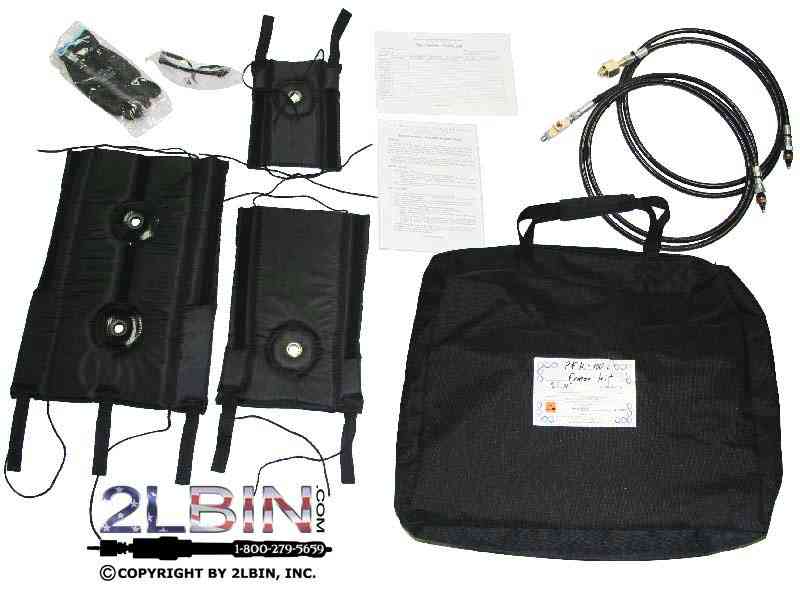
Complete 1/2"-4" Single Freeze Kit
Pipe Freezing Operating Instructions Manual PDF
The Pipe Freezing Kit eliminates the need to drain systems and shut down operating equipment when making pipe repairs. The kit uses liquid carbon dioxide to create ice plugs in sections of pipes. Kits are supplied with three freezing jackets for pipes ½"-4" (13-77mm) O.D.
To operate, turn off the pipe flow and attach a freezing jacket to the pipe upstream from the section needed to be repaired. Fill the freezing jacket with CO2 and an ice plug will form. After completing whatever work is needed, remove the jacket and the ice plug will defrost.
Note:
The Kit can be used for pipes ½"-4" (13-77mm) O.D. and includes three freezing jackets, two 7.8' (2.4m) hi-pressure hoses, a T-connector and a 20 lb (9.1 kg) CO2 cylinder (unfilled).
Pipe freeze plugging is a simple, cost-effective method to perform pipe maintenance or line modifications without shutting down your plant processes. Using liquid carbon dioxide (CO2) you can isolate the problem area in the line with SOLID freeze plugs of the fluid within the line. This allows the job to be done with no drain-down or refill, no loss of expensive process fluids, and no system downtime. Once the work is completed, the plugs are thawed and the line is back in operation. Standard freeze plugs range in size from ½" to 3" (13-77mm) O.D.
1 Unit of - 7.8’ (2.4m) high pressure hoses with a custom nozzle
1 Unit of - small jacket for pipes ½" - 1" (13-25 mm) O.D.
1 Unit of - medium jacket for pipes 1" - 1½" (25-38 mm) O.D.
1 Unit of - large jacket for pipes 2" - 4" (38-114 mm) O.D.
1 Tee connector
1 Pair of safety glasses
1 Pair of insulated gloves
1 Carrying bag & instructions for use
Pipe Freezing Operating Instructions Manual PDF
Operating Instructions – Pipe Freezing Kit Model PFK-5-3
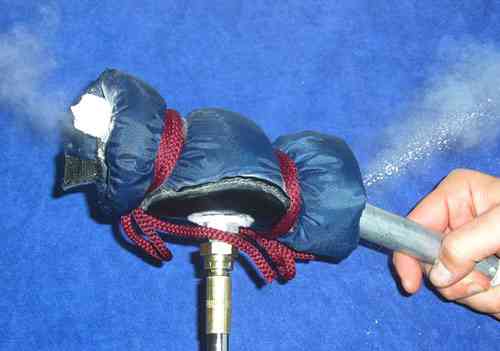 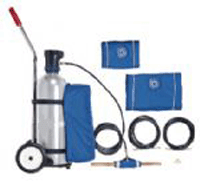 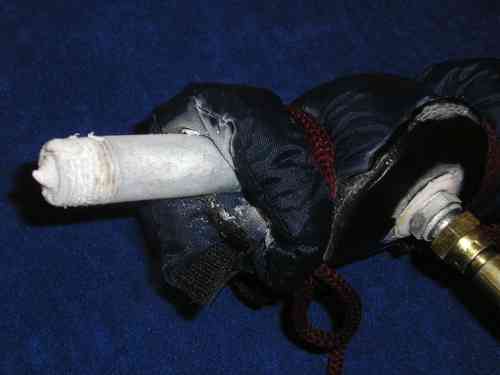 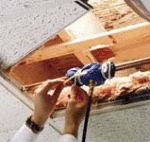 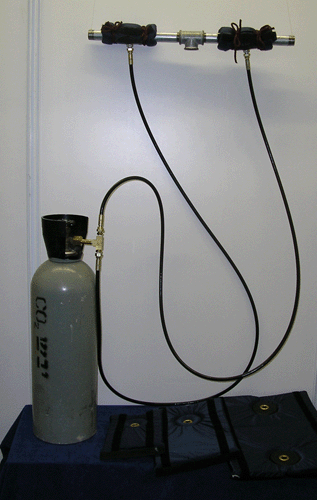
*Kit does not include Co2 bottle or cart however you can easily buy the Co2 bottles locally.
GENERAL:
The 2LBin.com pipe freezing kit uses liquid carbon dioxide to freeze stationary water in pipes. Very low "dry ice" temperature (-109ºF/-78ºC) inside the freezing jacket creates a secure ice plug within the pipe and
blocks the flow of liquid allowing repairs or modifications to be made to the piping system without draining or
shutting down the entire system. Three freezing jackets for 1/2" through 4" pipe are supplied with the 2LBin.com
Freezing Kit. The pipe freezing technique can be used on iron, lead, steel, copper and plastic pipe.
The 2LBin.com pipe freezing kit does not come with a empty CO2 cylinder. Check the local telephone directory or yellow pages for a source of CO2. Look under the headings "Gas-Bottled and Bulk" or "Welding Equipment and Supplies"
NOTE: the freeze kit will work only with a tank fitted with a siphon. A siphonless tank will not feed liquid CO2 -CO2 gas will not freeze pipes
GETTING READY:
1. Prepare the pipe to be frozen as follows:
- a. Stop the flow of water through the pipe. Moving water will not freeze.
- b. Water temperature should be at room temperature (75ºF/24ºC) or colder whenever possible. Warmer water takes much longer to freeze and hot water will not freeze.
- c. Thoroughly clean the section of pipe to be frozen. Dirt and layers of paint will lengthen the freezing process.
2. Check all hoses, freezing jackets, threaded parts and nozzles for wear and replace any worn components. Make sure the nozzle is clean and clear.
FREEZING PIPES
- Select the proper size freezing jacket based on the size of the pipe to be frozen.
- Connect nozzle assembly to jacket making sure that the nut inside of the brass grommet on the jacket in tightened securely to prevent leakage.
- Connect hose to the nozzle assembly and to the CO2 cylinder and tighten securely to prevent leakage.
- While holding the jacket firmly to prevent the nozzle from whip lashing, briefly open the valve on the cylinder to make sure the nozzle is clear.
- Determine the correct freeze location taking into account the following points:
- Always keep the freezing point 3 feet or more from a closed valve or connection.
- Always keep the freezing point 3 feet or more from another freeze. NOTE: failure to observe this 36 inch margin of safety can result in damage to pipe due to the expansion of water as it freezes.
- If torch cutting, welding or soldering is to be performed on the pipe, keep the freeze at least one foot from work for each inch of pipe diameter when working on carbon steel or iron pipe. Triple the distance on copper pipe. Cutting, welding or soldering too close to the freeze can damage the ice plug.
- Wrap the freezing jacket around the pipe using the Velcro strips to seal the jacket in place and tie the cords tightly around the ends of the jacket. After this step, the use of protective gloves is recommended to prevent frostbite.
- Completely open the valve on the CO2 cylinder.
- Squeeze the jacket while injecting CO2 to form a solid, even block of dry ice around the pipe. Crush any lumps that form in the ice.
- The following chart applies to freezing completely stationary, 70ºF water in carbon steel pipe. Adjust times according to actual conditions, allowing more time for warmer water or slight flow of water.
- Multiply all times by 3 for plastic pipe.
| JACKET SIZE |
SMALL |
MEDIUM |
LARGE |
| Pipe Size |
½" |
¾" |
1" |
1½" |
2" |
3" |
4" |
| Injection |
1 Min. |
1.5 Min. |
2 Min. |
5 Min. |
8 Min. |
10 Min. |
8 Min. |
| Waiting Time |
3 Min. |
5 Min. |
5 Min. |
5 Min. |
5 Min. |
5 Min. |
10 Min. |
| # Of Injections |
2 |
2 |
3 |
3 |
3 |
5 |
7 |
| Total Time |
8 Min. |
13 Min. |
21 Min. |
30 Min. |
39 Min. |
75 Min. |
126 Min. |
| CO2 Consumption |
1½ Lbs. |
2 lbs. |
4 lbs. |
10 lbs. |
20 lbs. * |
40 lbs.* |
65 lbs.* |
- Keep extra filled CO2 cylinders on hand. Have at least 2 full cylinders available when freezing 2-inch pipe, and 3-4 full cylinders for 3 and 4 -inch pipe. All cylinders must be equipped with a siphon and must be kept upright when in use.
-
- A full 20 pound CO2 cylinder contains about 18 pounds of usable CO2 and weighs 45 Pounds. An empty cylinder weighs 27 pounds. Weigh the cylinder between freezes to determine its approximate content.
- If you are unable to form a solid dry ice pack, check the nozzle for blockage, make sure the CO2 cylinder is not empty, and make sure the water flow in the pipe is turned off.
- Continue shaping the dry ice pack at 10 minute intervals during the freezing process. For optimum results, keep the ice pack formed tightly around the pipe.
- When the injection process is completed, frost should be formed on the outside of the pipe at the edges of the jacket. This indicates that the contents of the pipe are completely frozen. As long as this frost remains dry and stable, the freeze is being properly maintained.
- Leave the freezing jacket on the pipe while performing pipe maintenance.
As a safety precaution, make additional 30-second injections every 15 minutes.
When work is completed, remove the freezing jacket from the pipe and allow the freeze to thaw naturally. Do not attempt to thaw the freeze with a torch as thermal shock damage to the pipe can occur. Always wear protective gloves when handling jacket, dry ice pack or frozen pipe.
IMPORTANT INFORMATION ON CO2 AND CO2 CYLINDERS
- All A. Gur's CO2 cylinders are equipped with a siphon to drain liquid CO2 from the bottom of the cylinder. CO2 gas will not form dry ice.
- All A. Gur's CO2 cylinder valves are fitted with a safety-bursting disc to protect against over pressurization. If the cylinder is overfilled or subjected to temperatures over 100ºF, the bursting disc may rupture, allowing violent discharge of CO2 gas.
- Always weigh tanks to prevent overfilling.
- Store all CO2 cylinders out of sunlight and away from heat.
- Never transport cylinders in the driver's compartment of vehicle as sudden rupture of the bursting disc could distract the driver.
- The A. Gur's pipe freezing kit works best when the cylinder temperature is kept below 77ºF. It will not work if the cylinder temperature reaches 88ºF.
CAUTION: CO2 is heavier than air and will collect in confined or low-lying work areas. Always make sure there is good ventilation to prevent suffocation. CO2 gas is odorless and invisible. Disperse CO2 before entering a confined or low-lying work area.
|


